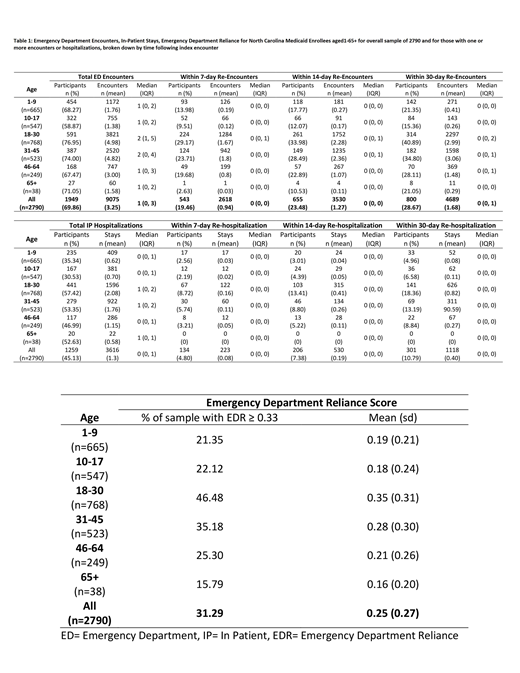Introduction: Sickle cell disease (SCD) is a complex disease for which pain is the hallmark. Pain from vaso-occlusive episodes is the number one reason for ED visits and hospital admissions. This paper reports Medicaid claims data from NC for individuals with SCD, including: 1) ED encounters and re-encounters within 7, 14 and 30 days; 2) hospitalization and re-hospitalization within 7, 14 and 30 days; and 3) ED reliance (EDR) score.
Methods: We examined Medicaid claims data from for patients with a diagnosis of SCD (ICD 9 CM codes: 282.6x, ICD 10 CM codes: D57.0x, D57.1, D57.2x, D57.4x, D57.8x) in North Carolina. Data is reported for a cohort of 2,790 patients with a diagnosis of SCD, age 1 to 65+ and enrolled at least 11 months in NC Medicaid between March 1, 2016 and February 28, 2017. ED re-encounters and re-hospitalizations within 7, 14 and 30 days were identified using the time between the date of service listed on the ED or hospital claim and the next date of service in the subsequent claim. Individual ED Reliance (EDR) score was calculated as the total number of ED encounters divided by the total ambulatory visits (outpatient + ED encounters) per enrollee, (ambulatory visits reported elsewhere). Similar to Kroner et al, an EDR of >0.33 was considered a high score. Inpatient claims were identified using a category of service code indicating hospitalization.
Results: The participants in the sample (n=2790) were majority female (57.92%), lived in metropolitan areas (77.63%) and had a mean age of 23.05 years old (SD=16.06). Of the 9,075 total ED encounters, 69.86% of the total sample had an ED encounter during the 12-month study period. There was a mean of 3.25 (SD=7.38) and median of 1 (IQR = 0 - 3) ED encounters per patient for the sample. Those who were 18-30 years old had the highest mean and median ED encounters per patient (4.98, SD= 9.34 and 2, IQR 1 to 5). The 31-45 year old group had the second most, with 4.82 (SD= 11.03) total ED encounters. The percentage of the sample with an ED re-encounter within 7, 14, and 30 days was also highest among the 18-30 year old group (29.17%, 33.98% and 40.89%) followed by those 31-45 years old (23.71%, 28.49%, and 34.80%), respectively. The 31-45 age group had the second most hospitalizations/patient and re-hospitalizations. The mean EDR was highest among 18-30 year old patients (0.35) and 46.48% of this age group had an EDR of 0.33 or greater. In the 31-45 year-old age group, the mean EDR was 0.28 and 35.18% had an EDR of 0.33 or greater. The overall sample had a mean of 1.30 (SD= 2.75) hospitalizations/patient. The 18-30 year old age group also had the highest mean total hospitalizations (2.08, SD= 3.72) and mean re-hospitalizations within 7 (0.16; SD=0.77), 14 (0.41; SD=1.68), and 30 (0.82; SD=2.79) days. The 31-45 age group had the second most hospitalizations/patient and re-hospitalizations (Table 1).
Conclusions: Overall, increasing age coincided with increased ED and inpatient utilization, as well as with the period of transition from pediatric to adult SCD care. Furthermore, high EDR was most prevalent in the 18-30 age group. Our study further supports the need for increased focus on acute care utilization in the 18-45 year-old age group and considerations for improved care transition interventions.
Tanabe:NIH: Research Funding; AHRQ: Research Funding. Shah:Novartis: Consultancy, Research Funding, Speakers Bureau; Alexion: Speakers Bureau; GBT: Research Funding.
Author notes
Asterisk with author names denotes non-ASH members.


This feature is available to Subscribers Only
Sign In or Create an Account Close Modal